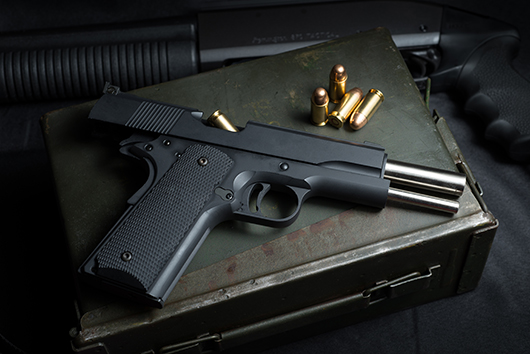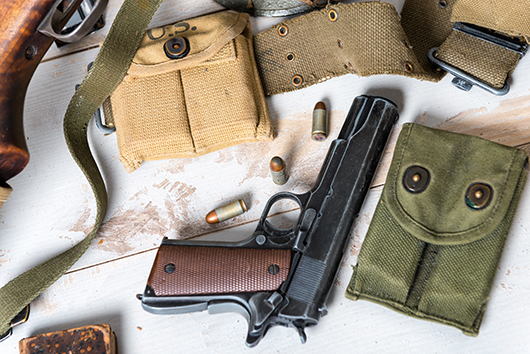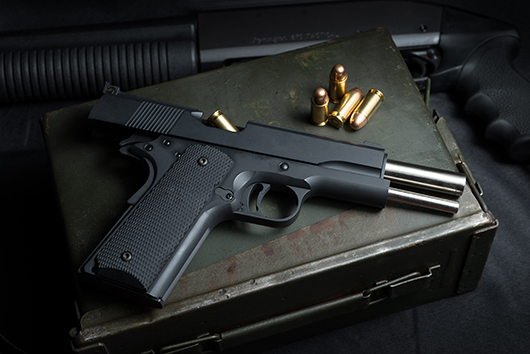Best IWB Holsters for Colt 1911 Handguns
Jan 8th 2021

When the Colt 1911 was first adopted by the U.S. Army in the year of its namesake, a soldier or Marine would carry it in a leather field holster with an over flap. This holster’s purpose was to retain the weapon, especially when on horseback and protect it from the weather.
Concealed carry requires a balance — the holster has to retain and protect the weapon without compromising access. When you need to draw your sidearm, you’re apt to need it quickly, and this article will discuss what you should look for when selecting one of the numerous holsters on the market for your 1911 handgun.
The 1911 pistol has gone through several iterations since the early 20th century and so have the holsters and magazine pouches that gun owners wear.
The Colt 1911
Designed by John Moses Browning in cooperation with Colt’s technical staff for the United States Army, the 1911 is a semi-automatic, locked-breech, single-action-only handgun.
Initially chambered in .45 ACP (Automatic Colt Pistol), Browning’s famous design has been chambered in everything from .22 Long Rifle to .50 G.I.
The pistol is operated using Browning’s tilting-barrel short-recoil operation, which has become a mainstay of modern combat handguns.
Today, dozens, perhaps even hundreds, of different companies manufacture the 1911-pattern handguns. Despite being phased out of U.S. military service in 1985 in favor of the Beretta M9 in 9mm, the 1911 is still popular among private citizens for competitive target shooting and self-defense.
This long-standing popularity is due, in part, to its ergonomics and single-stack magazine. The magazine holds 7–9 rounds of ammunition, depending on the caliber, in a single feeding column. Hence, the frame is narrower than some of the high-capacity competitor models. Combined with a 74° grip angle and a relatively light, crisp sliding single-action trigger, it’s not hard to understand why this classic remains in high demand.
The platform offers significant versatility regarding size, weight, caliber, magazine capacity, and other features that enhance its suitability for winning formal matches or surviving deadly encounters.
Pistol Size
1911 pistols come in several sizes, calibers, and configurations to meet gun owners’ diverse demands. You’ll find Kydex holsters designed for full-size 1911 pistols, with and without accessory rails, Commander-type weapons with shorter 4” and 4.25” barrels, and Officer’s ACP handguns with 3”–3.5” barrels.
Waistband Holsters
If you want to carry your 1911 in a waistband holster, you’ll need a good belt. These can be made from leather or a synthetic material but should support the holster and handgun’s weight together, especially when you’re running. Waistband holsters come in several types, but the two most popular are IWB and OWB.
IWB and OWB Holsters
When selecting a waistband holster for the 1911, the first choice that you’ll have to make is how you want to carry it.
IWB, or inside-the-waistband, holsters are superior for deep concealment because they rely on the trousers to hide the lower half of the holster and pistol. IWB, however, is preferable for comparatively lightweight, compact handguns. In the context of the 1911 design, this means Commanders and Officer’s ACP pistols.
OWB, or outside-the-waistband, holsters are more comfortable for carrying handguns for an extended period. This type is also more suitable for carrying a 1911 in its full-size configuration. If you want to carry a Colt Government Model with a full-length barrel and slide, an OWB 1911 holster is a perfect choice.
Sweat Guard
You may have seen this term used in reference to gun holsters. Also known as a sweat shield, this is the part of the holster that covers the pistol slide, ensuring that it doesn’t make contact with your skin or clothing. The sweat guard protects the steel slide from perspiration, hence the name, which can promote corrosion.
It also increases your comfort as you carry a firearm. Rather than having the serrated slide, which may also be hot or cold, pressing against your side, leather or Kydex acts as a barrier. If you carry your 1911 in an open-top holster that allows for quick drawing, you may prefer for the pistol not to rub against your body as it’s being ripped out of its holster and deployed.
Spare Ammunition

In the old days, gunslingers and police officers carried ammunition in belt loops or loosely in snap-closure pouches made from leather or canvas. Today, we have something better.
First, don’t neglect the importance of carrying spare ammunition for your sidearm. You don’t have to be a police officer to benefit from additional magazines on your person.
In the unfortunate event that you must use deadly force to defend your life, no one can predict what the circumstances of that encounter will be like, so it’s vital that you prepare yourself. Rather than keeping spare magazines in your vehicle where they’re not available when you need them most, it’s best to keep them on your belt, under your arm, or in a pocket.
It’s customary to pair a gun holster with one or two magazine pouches located on the firearm’s opposite side. If you carry your gun on your right side, you would rotate the pistol in your dominant hand and depress the magazine release with your right thumb as you reach for a spare magazine with your left hand.
Appendix Carry
Carrying a handgun in this position, roughly 12 or 1 o’clock for a right-handed shooter, is one of the fastest and most concealable. When wearing an untucked T-shirt or another loose-fitting cover garment, you raise your clothing with your support hand and draw with your strong hand. However, despite its advantages, it remains controversial because it poses an additional safety concern.
In this position, the muzzle of your gun is pointing toward your groin or your femoral artery. If you experience an unintentional discharge, the results are potentially far more devastating. Strict observance of firearms safety rules is indeed the first line of defense against an accidental discharge, but there are other factors that you should bear in mind.
Holster Safety
First, holster design can increase or minimize the risk of carrying a firearm in general, and appendix carry in particular. A good gun holster should always cover the trigger guard of the handgun so that when you draw it, your index finger remains straight alongside the frame until your sights are on the target and you’re ready to fire.
Second, the material that the holster is made from can play a significant role. Soft leather IWB holsters whose mouths are collapsible can be dangerous for re-holstering. If the holster’s mouth becomes deformed, part of it may enter the trigger guard as you return the weapon to its holstered position. If you re-holster your pistol forcefully under time pressure or stress, this can cause an unintentional discharge, especially with striker-fired handguns that rely on passive safeties.
The 1911 pattern offers a distinct advantage relative to some more modern combat handguns in this respect. As the pistol has a manual thumb safety lever, you can engage the safety reflexively before the weapon is re-holstered. Thus, if the holster does interfere with the trigger, the weapon won’t fire.
Holster Retention
Many leather holsters rely on a thumb break or other fastener for retention. Kydex carry holsters, however, often retain the pistol through friction. This kind of retention, passive and adjustable using screws, means that the only thing you have to remember is to obtain a full firing grip and rip the pistol out.
Other holster designs, such as those with an over flap, provide superior retention at the expense of access. For a concealed or open carry holster, rather than a cavalry field holster, draw stroke is essential.
If you are forced into a situation where you may need to use deadly force, you need to be able to bring your weapon into action quickly.
Kydex Holsters
While leather is still a popular choice as a holster material, Kydex offers several advantages, regardless of whether your carry gun is a 1911 or a Glock. These include:
- Toughness: As a durable thermoplastic, Kydex is resistant to abrasion and impact.
- Chemical and water resistance: Gun oils, cleaning solvents, insect repellants, and water are no problem for a Kydex holster. What would stain a leather holster, and cause it to swell, will leave Kydex unaffected.
- Rigidity: Even hard leather can deform, whereas Kydex maintains its shape, ensuring that you can safely and reliably draw and re-holster with one hand.
In Conclusion
Slim and ergonomic, the 1911 remains a prevalent choice for self-defense, and the design lends itself well to IWB carry. At Incognito Concealment, we appreciate all firearms, including the venerable 1911 platform, and believe in providing new and experienced shooters alike with guidance when choosing a 1911 holster. Call us at (586) 333-4240, and we’d be happy to help you make the choice that’s right for you.











